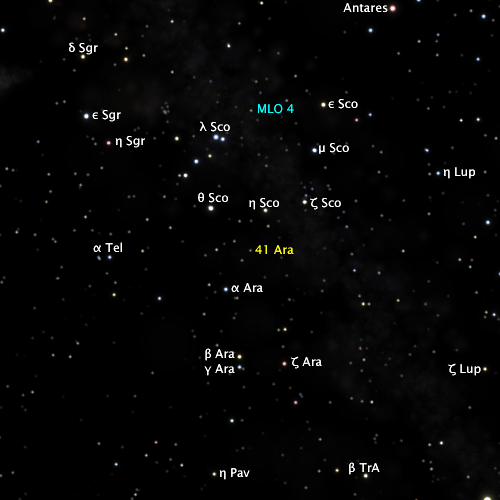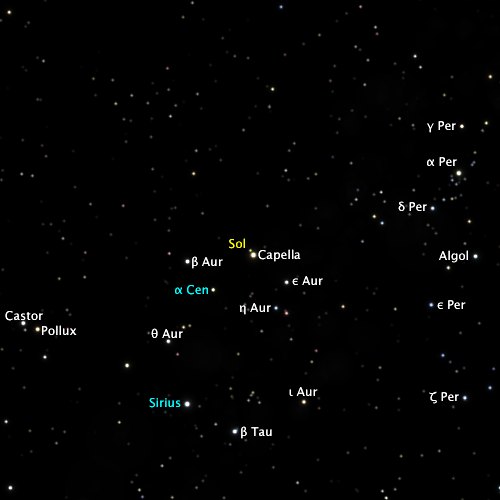as seen from Sol.
41 Arae.


| Right Ascension | 17h 19m | |
|---|---|---|
| Declination | −46° 38' | |
| Distance | 28.57 ± 0.34 ly | |
| Star | 41 Arae A | 41 Arae B |
| Spectral Class | G8V | K7V |
| Estimated Mass | 0.74 × Sol | ? |
| Luminosity | 0.42 × Sol | 0.022 × Sol |
| 41 Arae as seen from Sol. |
Sol as seen from 41 Arae. |
|---|---|
 |
 |
| Star | Magnitude | Distance |
|---|---|---|
| Canopus | −0.64 | 305.3 |
| Arcturus | 0.22 | 41.5 |
| Rigel | 0.22 | 879.7 |
| Achernar | 0.31 | 130.6 |
| Beta Centauri (Hadar) | 0.47 | 367.8 |
| Betelgeuse | 0.55 | 520.3 |
| Alpha Crucis (Acrux) | 0.63 | 301.4 |
| Spica | 0.87 | 236.9 |
| Vega | 0.88 | 37.2 |
| Beta Trianguli Australis | 0.92 | 16.8 |
| Antares | 0.96 | 527.3 |
| Destination | Distance |
|---|---|
| Gliese 667 A | 8.2 |
| Gliese 783 | 16.4 |
| Gliese 785 | 19.6 |
| Planet | SMA (AU) |
Orbital Period |
e | Equatorial Diameter (km) |
Mass (Earths) |
Density (g/cm3) |
Gravity (Earth g) |
Atmospheric Pressure (Earth=1) |
Sidereal Day |
Mean Solar Day |
Axial Tilt |
Known Moons |
|---|---|---|---|---|---|---|---|---|---|---|---|---|
| Hamlet | 0.2833 | 63.952 d | 0.0284 | 6377 | 0.09985 | 4.39 | 0.3993 | 0.0000140 | 63d 22h 51.3m | Synchronous | 00° 01.4' | 0 |
| Horatio | 0.4398 | 123.73 d | 0.0106 | 7071 | 0.1382 | 4.46 | 0.4496 | 0.00391 | 123d 17h 33.4m | Synchronous | 00° 46.5' | 0 |
| Polonius | 0.7019 | 249.46 d | 0.0629 | 5946 | 0.07168 | 3.89 | 0.3298 | 0.00253 | 1d 23h 18.2m | 1d 23h 40.8m | 11° 21.4' | 2 |
| Gertrude | 1.062 | 1.2712 y | 0.0139 | 10270 | 0.4745 | 5.03 | 0.7316 | 0.638 | 16h 39.5m | 16h 40.9m | 32° 33.1' | 0 |
| Claudius | 3.600 | 7.9322 y | 0.0287 | 51580 | 14.66 | 1.32 | 0.8957 | &mdash | 09h 33.5m | 09h 33.6m | 25° 57.4' | 7 |
| Name | Diameter (km) |
Period (days) |
Semimajor Axis (km) |
Ecc | Inc |
|---|---|---|---|---|---|
| Natural Satellites of Polonius | |||||
| Ophelia | 73 | 2.015 | 27990 | 0.0004 | 0.05 |
| Laertes | 17 | 3.573 | 41010 | 0.0294 | 1.32 |
| Natural Satellites of Claudius | |||||
| Barnardo | 173 | 1.083 | 109000 | 0.0094 | 0.03 |
| Francisco | 1672 | 2.561 | 193500 | 0.0149 | 0.64 |
| Marcellus | 1543 | 5.121 | 307200 | 0.0196 | 1.19 |
| Voltemand | 1005 | 13.16 | 576200 | 0.0345 | 3.01 |
| Cornelius | 893 | 26.15 | 910800 | 0.0752 | 2.13 |
| Reynaldo | 80 | 39.55 | 1200000 | 0.0591 | 3.16 |
| Osric | 132 | 53.27 | 1464000 | 0.0735 | 13.30 |
Polonius is a small world in the habitable zone around 41 Arae A. The world has a mass of about 0.072 Earth masses and is thus too small to be terraformed. The world has a very thin, unbreathable atmosphere. The world is named after the character from Hamlet, as are the other planets in this system.
Polonius has a long day nearly twice the length of Earth’s day.
The world has two moons, Laertes and Ophelia.
Ophelia orbits just outside the radius of the synchronous orbit. It moves so slowly across the sky of Polonius that it almost seems to stand still; the time from moonrise to moonset is about six weeks. Ophelia has an apparent size that varies from about nine minutes of arc at moonrise and moonset to about 10 minutes of arc at the zenith, or about one-third of the size of Earth’s moon in apparent size. This variation in apparent size is due to the observer being one Polonian radius closer to Ophelia when that moon is at the zenith.
Laertes orbits farther out and thus moves much more quickly across the sky. Laertes appears much smaller in the sky than Ophelia, with an apparent size of about 11⁄3 minutes of arc. An observer needs good eyesight to resolve the disk of Laertes with the naked eye.
The world was colonised as a mining colony and then attracted free settlers. The world is a tax haven. It also has a significant industrial and mining base.
The long day makes it necessary for the residents to live with an artificial day half the length of the natural day. Every second “day” is actually the Polonian night. The artificial environment of the Polonian colony causes this to be less of a problem. The Polonian colony is mainly an indoor colony with an artificial environment, and any outdoor work such as mining that must be done at night uses artificial lighting during the long Polonian night.
Principal imports: Fertilisers, water, nitrogen, oxygen, carbon dioxide
Principal exports: Light ores, manufactured goods
| Planet | SMA (AU) |
Orbital Period |
e | Equatorial Diameter (km) |
Mass (Earths) |
Density (g/cm3) |
Gravity (Earth g) |
Atmospheric Pressure (Earth=1) |
Sidereal Day |
Mean Solar Day |
Axial Tilt |
Known Moons |
|---|